11:55 AM
Something New: Chariots
Mister Nizz
chariots, convention, Fast Shuffle Chariot Racing, Game Design, TriaDCon

Building a Chariot Racing Game for dirt cheap!
I've always wanted to put together a chariot racing game for running either Circus Maximus, an overly complicated but fun racing game from Avalon Hill that translates perfectly into miniatures, or something like Steve Gibson does with his Fantasy Chariot game Circus Magicus, or come up with something by myself. The answer to that was pretty easy: I'd come up with something myself. Steve does the fantasy chariot thing very well indeed and there's no need for me to try to repeat a niche he does far better than I ever could. I don't have ten years to look for the perfect 15mm fantasy chariot figures, to boot. Likewise, the Circus Maximus game from Avalon Hill can be huge amounts of fun (for me personally) but it can also be horrendously complicated for a new player to absorb. So I got to thinking about what I would like to put into a Chariot Racing game. The game I envision would be not so much fantasy as Ben-Hur like; fast and furious, but with lots of gritty combat included... but combat that makes sense. It would have to play fast and loose, yet still pay homage to real physical and physiological laws. That means it will have to have fun items like corner strain and endurance and physical damage to the chariots. It would STILL have to play fast and be an easy game to teach to youngsters. Of course, it would have to have tons of fun, historical details in it like combat between chariots, death defying leaps from one chariot to another, rams, whipping, scythes.. Oh, did I mention I didn't want to spend an arm and a leg on it?
So that rules out things like buying it all in metal (even though 15mm chariots aren't that expensive, really) and lovingly crafting a race course by woodburning it into a hand rubbed mahogany board...
Instead, I opted for a piece of cloth with the course inscribed, and some cheap plastic chariots. Here's the basic "Light Chariot" I chose for the first outing of this game:
This is the Atlantic/Nexus "Egyptian Cavalry" Chariot. Two horses are two less than ideal, but we can always make one horse represent two in the game. Besides, the box comes with variant drivers, which is a huge benefit for a game that involves racing, COMBAT chariots:
Price per box: 6 bucks. I bought three, painted up two and am in the process of turning the third one into a lot of track rubble, a couple of extra chariots and a lot of driver casualties.
I have Atlantic's "Greek Cavalry" on order as well:
I envision these becoming "Heavy Chariots" as the game develops.
Painting plastic can be a bit problematic but the advent of Kryolan's Fusion plastic paint really helped matters. The end result was pleasing and functional:
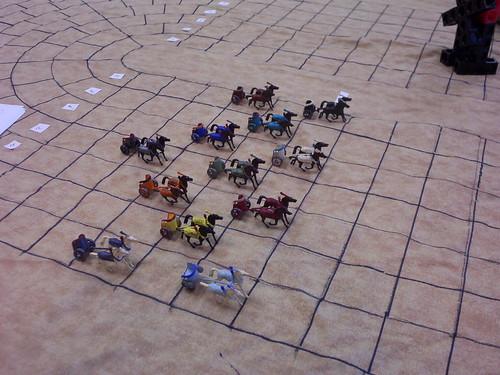
Two of the horses chipped during our test game but it's a cinch to fix this.
Step one, the real drag, was:
DESIGNING A RACE COURSE
I rather like Steve Gibson's template approach where he created curved sections of track that can be configured into almost any kind of race track, and no two races are the same. However, it's a lot of work to make something like that happen! Steve may be possessed of infinite patience and drafting tools, but I have neither. However, I do have one advantage that Steve never had: Steve Gibson as a neighbor!
At our recent Pre-Gencon Painting Day (always fun!) at Steve's house, I utilized his templates to make the necessary curves (the hardest part, really) of a standard traditional CIRCUS MAXIMUS race course. I used cloth to pencil it in-- a nice hunk of cheap dirt-patterned stuff I found at Wal-Mart on sale (grand total: 5 bucks). I bought far more than I would end up using.
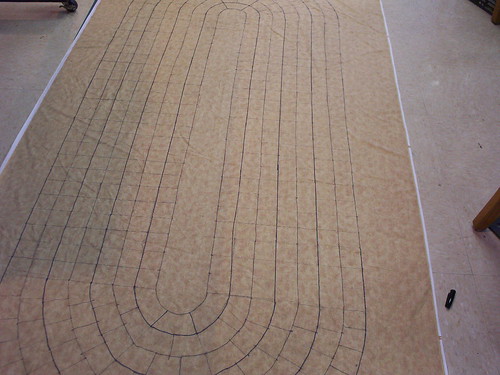
Why the standard pattern? Well, why not? It's easily recognizable, easy to understand and easy to maneuver on. I will get enough replayability out of it to make it worth the effort.
So I sweated on Steve Gibson's driveway as I carefully templated the course out by tracing around his existing course pieces he so carefully cut out, long ago. Fortunately enough, the light chariot (in 20mm) fits into the basic square perfectly. Wider chariots (e.g., 4 horse) will certainly overlap, but that is a trifling matter.
Then, with a ruler and a Sharpie (and indoors in the air conditioning this time), I went over the lines with indelible ink. Fortunately, this time I had an assistant for Gaming Camp (see the previous post) named Tim to spell me. Thanks, Tim!
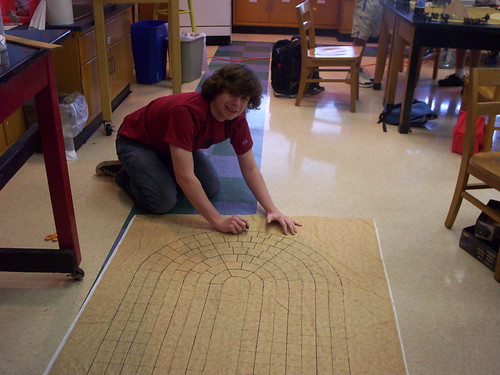
In this shot, we see the light chariots are a pretty good fit. Our lines on the course could be a little straighter in places, but we did a fairly good job with the map and I am pleased. The course here has far fewer squares than the Avalon Hill Circus Maximus map, but it also finishes quicker, too.
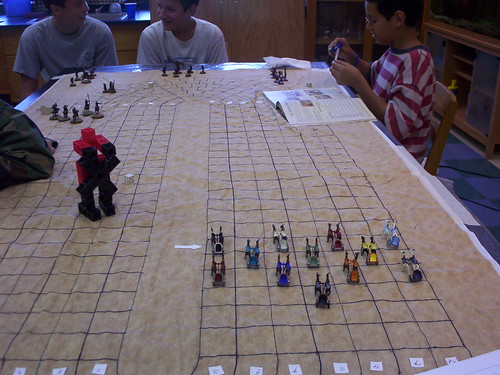
Next, the rules themselves..
Early on, I decided I wanted a game where chariots could race, but also fight each other during the race, in a way far more ritualized than ramming and whipping.. So I added in archery and grappling (melee). I also wanted the combat as well as the racing to resolve itself quickly. This led to a somewhat unique (for me) fusion of a playing card-driven design and some dice rolling. I generally like my card designs to be pure (no dice needed) but that wouldn't work here-- there are too many limits on the card deck to create good combat effects in my experience. So I went to an activation by cards method with SOME die rolling that works like this:
Each Racer is dealt FIVE standard playing cards, which he divides into red and black.
In a general sense, black is for racing, red is for fighting and defending. Aces always equal 1, Jacks always equal 11, etc. If a player has no black cards, he says "No Black Mulligan" in a voice the race steward can hear, and he gets a new hand.
One of these cards is sacrificed for initiative. This is played face up on the Spina (inside) section of the race track. The race steward (me) flips them over as he calls racers to perform their actions.
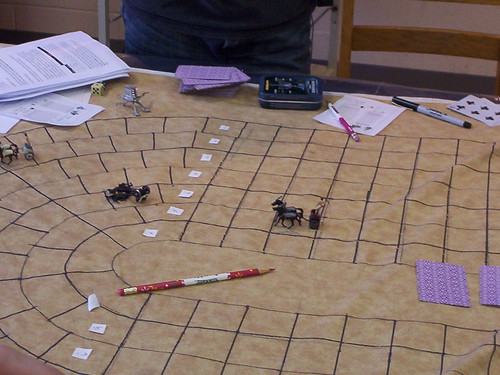
They play as MANY BLACK CARDS as they like. Add them up (if possible) and this is the number of spaces you can go. If you wish to attack, this action must take place at the start of the turn. Attacks are made with RED Cards and they are committed to attack in different ways-- ramming, archery, grappling, etc. Likewise, you can sacrifice an extra card if someone attacks YOU, as a sort of savings throw.
Just like Circus Maximus, corner strain exists, damage to chariot, team and driver exist, Speed Limits on turn exist and dramatic chariot flipping exists.

First Session Feedback:
Our first test game went very well The limitations of the card hand are overcome by the fact that it changes constantly and the poor schnook who only got a black 7 one turn might get 2 Jacks and a 10 the next turn. Naturally for the audience (males in their early teens) the combat aspect was a big draw, as this crashed chariot attests to-- nothing like a big dangerous flip result as a result of corner strain!
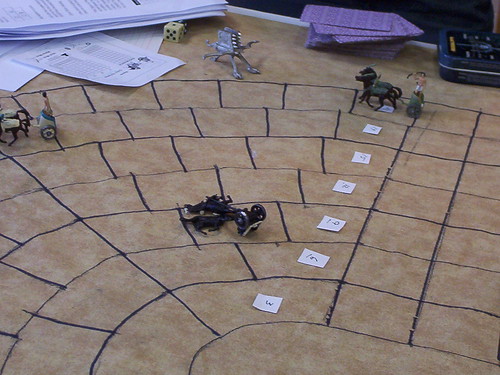
I will be reworking the ram rules, as they proved to be confusing and the procedure didn't give balanced results. Jumping from chariot to chariot is futile and suicidal (as it would be in real life) but the kids want it in there, so I give them a shot at it. Corner strain is a bit too severe in the first draft, I may temper it a bit... we had three chariots flip over as a result of strain.
So the game, which I am considering calling FAST SHUFFLE COMBAT CHARIOTS might have the rules done for TRIADCON!
Other plastic chariot models:
Ceasar Miniatures is making some excellent plastic chariots in 20mm right now, and is putting out quite a variety:
H011 - Assyrian Chariot
H012 - Hittite Chariot

H014 - Mitanian Chariot

with Mycanean (H021) and Egyptian (H024) chariots forthcoming. A company to watch.
Zvezda makes a pretty neat looking Persian heavy chariot. Note the scythes.
The Lucky Toy company's King Porus' Army set has a nice understated little chariot.
It also has a nifty elephant in the same package. No idea what I'd do with it, though.
Finally, the Italieri gladiator set in 1/72 has a nice "gladiator chariot" inspired by the famous movie scene.